The OLD LUGGERS online-ACADEMY of
MARINE PAINTING: Shore, Sea and Sky
This section of the course will:
-
Offer a range of pictorial schemes which could be developed as a basis for your own paintings.
-
Examine the way light and viewpoint determine the appearance of the water surface.
-
Give a guide to painting reflections.
The series of small sketches below can be used as a 'swatch' of schemes showing varying conditions through the day and the year. Develop them as backdrops for your own full scale work. It shouldn't be too difficult to devise intermediate states of weather if you need to. A lot of the best known marine paintings would fit these basic types.
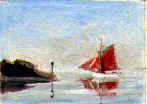 |
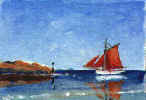 |
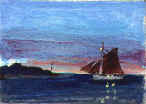 |
||
|
Full sun |
Dusk |
|||
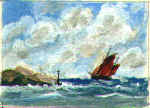 |
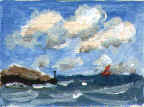 |
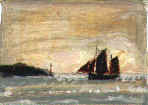 |
||
|
Fair weather back-lit cloud, good breeze. |
Ditto - top-lit |
'Golden glow' |
||
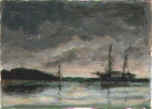 |
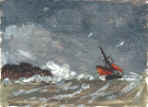 |
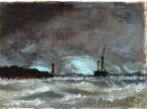 |
||
|
A Gathering Storm |
Onshore Gale |
Squall with driving rain |
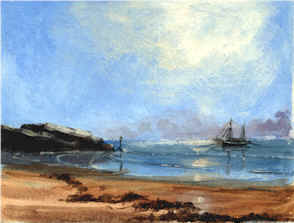 |
.'After the Storm' - acrylic sketch by Austin Hill
.All these sketches were painted using cobalt and prussian blue, burnt umber, raw sienna and white. Local colour effects were achieved with dabs of vermillion hue (sails), alizarin crimson (dusk sky), turquoise ( rain-storm sky at the horizon). All these colours are taken from the list suggested in Equipment & Colours. In 'After the Storm' perhaps you can see how perspective is achieved by having the line of deposited seaweed converge with the water's edge at its furthest point. The fall of the beach is suggested by the direction of the damp sand areas (burnt umber). One last note about skies. In higher latitudes the sun is lower and therefore yellower. Winter light is very yellow. For this reason, northern skies are often best achieved with prussian blue and turquoise - despite the claimed fugitive quality of the former, my 50 year old work is still OK! Cobalt blue does well at the high point of a summer sky while ultramarine can produce something truly tropical. Where yellow has to be introduced in a sky, use only raw sienna and white. Any other yellow will combine with blues to make a sickly unreal green - especially in watercolour.
If the surface were totally undisturbed, it would give a mirror image of everything above it but a few tones duller because of the local self-colour of the water and the amount of light it absorbs. Canadian lakes often oblige with this sort of image. But as it is, the surface usually is disturbed and the image is broken up in various ways. It's a big subject for marine painters so I've made a fairly large sketch with notes below which hopefully will show what happens better than I could describe it.
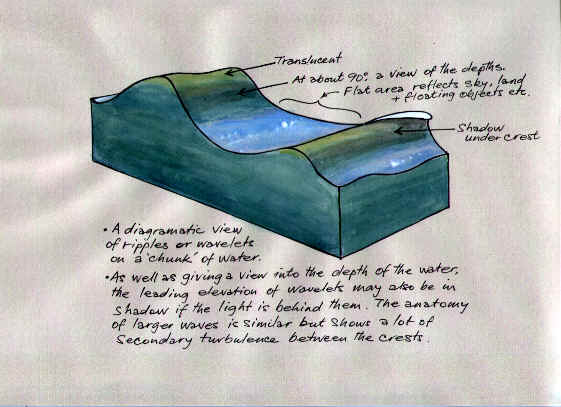
- And, conversely, if the light source is in front of the wave - and especially at lower angles - the leading face will be lit with shadow behind. The next section on Reflections will show what happens when a ripple etc. crosses light and dark reflected areas.
.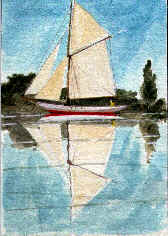 |
.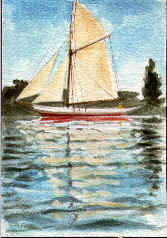 |
'The Angle of Reflection is always equal to the Angle of Incidence which is the angle at which an object is placed to the reflecting surface.
Reflected points are found, therefore, on lines at right angles to the reflecting surface.
Lines that are parallel to a mirror - ie. the water surface in our case - have parallel reflections which vanish to a common point.
Perpendiculars on horizontal planes - the water surface - have perpendicular reflections of equal height.' From 'Background to Perspective' by William Coombes
The two contrasted frames above show a mirror calm on the left and the more usual disturbed surface on the right. The mirror calm produces a near mirror image. There are some very slight ripples and where these cross the reflections of dark objects they show up light and dark where they cross the light areas of reflection. As a painting device, the ripples also help to establish the presence of the water surface. (This is a recurrent theme in painting - we see things in terms of light on dark, dark on light - how else?)
The disturbed surface in the right frame shows how the reflections have been fragmented and, because of the interruptions to the images, elongated. See how the reflection of the cypress on the right has been 'stretched' in bits nearly to the foot of the frame. As the surface becomes even more disturbed the images can lose nearly all their definition to the point where they are little more than smudges of the reflected colour. An this incidentally fits quite well with another tenet of painting which is the need to carry hints of main area colour into other areas of your work to establish a general harmony. So consider introducing hints of reflection even into a storm force 12 - take a look at Turner's work via useful links.
Reflections - points to remember :
-
On flat water, a reflection is the same size as the reflected object.
-
On disturbed water the reflection is broken into segments and stretched down the frame.
-
Even in flat water a straight edge or spar may show some minor twists in its reflection.
-
An upright mast will have a straight in-line reflection below it at a depth at least equal to the height of the mast.
-
A canted mast eg. to the right, will be reflected to 'mirror' right and vice versa.
-
All vertical objects across the width of a picture are reflected parallel to eachother.
-
When you move to another view point, all the reflections move around to remain parallel with your line of sight - try it.
-
The brilliance of a reflection is dictated by the amount of light falling on - or generated by - the reflected object. On very dull days a reflection can be a bit of featureless ghost.
And finally - don't confuse reflections with shadows. The direction of shadows is determined by the direction of the light source and they won't move when you do, unlike reflections. Shadows on water incidentally are usually best represented by what you assess the self-colour of the water to be - there is nearly always a lot of diffused light around and it's a translucent medium after all.
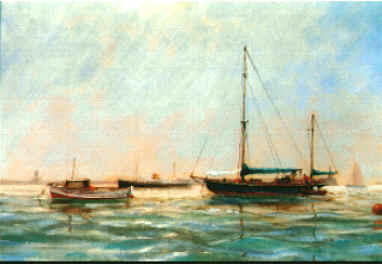
'Going Aboard Lilymaid II' by Austin Hill
Putting some of the above ideas into practice.
TABULATED SCHEMES WATER SURFACE RELECTIONS
© Austin Hill 2000
Home Introduction Equipment & Colours Preparation, Drawing & Composition
Demonstration Useful Links & Book List The Newfoundland Project
The Old Luggers online Academy of Marine Painting is an ENTIRELY VIRTUAL establishment, a FREE -TO -AIR leisure and recreational site which we hope you'll enjoy and even pick up some useful painting hints. Any of the Old Luggers material can be downloaded and copied for recreational and private but not commercial use. Apart from the many illustrations reached via the links, all the images in Old Luggers are from copyright work by British marine artist Austin Hill. And finally - a LUGGER is a traditional small working boat carrying a loose-footed four sided sail hung from a yard, but you knew that of course !
